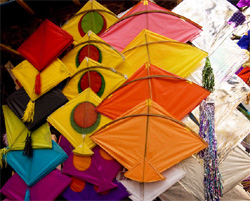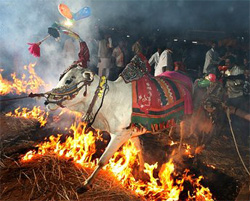| Makar Sankranti |
 |
Makar Sankranti marks the commencement of the Sun's journey to the Northern Hemisphere (Makara raasi), signifying the onset of Uttarayana Punyakalam, and is a day of celebration all over the country. The day begins with people taking holy dips in the waters and worshipping the Sun.
Traditionally, this period is considered an auspicious time and the veteran Bhishma of Mahabharata chose to die during this period. Bhishma fell to the arrows of Arjun. With his boon to choose the time of his death, he waited on a bed of arrows to depart from this world only during this period. It is believed that those who die in this period have no rebirth.
|
 |
The Indo Gangetic plain begins this day with taking dips in the Ganga and offering water to the Sun god. The dip is said to purify the self and bestow punya. Special puja is offered as a thanksgiving for good harvest. According to folklore, girls who take the holy dip get handsome husbands and boys get beautiful brides.
Til and rice are two important ingredients of this festival. In the rice-eating belt of Bihar and eastern Uttar Pradesh, people have a special rice-centric meal on this day.
|
Also known as Gangasagar Mela, on this day, people come from all over India for a ceremonial cleansing in the river Hooghly, near Calcutta. In Maharashtra, when two persons greet each other on this festive day, they exchange a few grains of multi-coloured sugar and fried til mixed with molasses and say "til gud ghya, god god bola" (henceforth, let there be only friendship and good thoughts between us).
In Gujarat, the pandits consider Sankranti as an auspicious day to grant scholarships and certificates of merit to students who have successfully completed their studies in philosophy. In a Hindu household, new utensils are purchased and used for the first time. Brightly coloured kites dot the skies on this day.
|
 |
In Karnataka, men, women and children attired in colourful tunics visit friends and relatives and exchange pieces of sugarcane, a mixture of fried til, molasses, pieces of dry coconut, peanuts and fried gram. The significance of this exchange is that sweetness should prevail in all the dealings. As part of the festival, cows and bulls are given a wash and the horns are painted with bright colours and decorated with garland, and are taken in a procession in the village to the accompaniment of pipes and drums. In the night a bonfire is lit and the animals are made to jump over the fire. |
It is a big event for the Tamils and the people of Andhra Pradesh. The Telugus like to call it 'Pedda Panduga' meaning big festival. The whole event lasts for four days, the first day Bhogi, the second day Sankranti, the third day Kanuma and the fourth day, Mukkanuma.
One month preceeding Sankranti is called Dhanurmasam and is also an auspicious period. People wake up early, take bath and go around the streets singing devotional songs. Houses are whitewashed and farmers clean their warehouses. Colorful rangoli (muggulu) are drawn in the front yards of every house during this month. These artistic floral designs are drawn on the floor with rice flour or fine powder from limestone. These patterns are decorated with marigold placed on cowdung balls. Colorfully dressed young girls go round them singing songs.
|
|
|
| Religions |
In India, religion is a way of life. It is an integral part of the entire Indian tradition. For the majority of Indians, religion permeates every aspect of life, from common-place daily chores to education and politics. Secular India is home to Hinduism, Islam, Christianity, Buddhism, Jainism, Sikhism and other innumerable religious traditions. Hinduism is the dominant faith, practised by over 80% of the population. Besides Hindus, Muslims are the most prominent religious group and are an integral part of Indian society. In fact India has the second largest population of Muslims in the world after Indonesia.
|
| Read more about Indian Religions |
|
|
